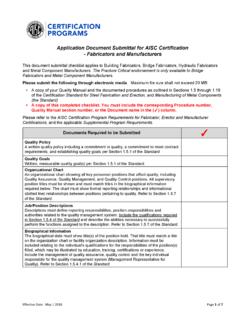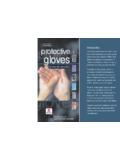Transcription of SELECTING and SPECIFYING - AISC
1 SELECTING . and SPECIFYING . Wesley B. Myers, An insider's guide to SELECTING and SPECIFYING K-series, LH, DLH-series joists and joist girders S. ince the Steel Joist Institute based on L/360 allowable deflection, double KCS joists can be used, or an adopted the first standard erection stability bridging require- LH-series joist can be selected. specification and first load ments and approximate joist weight. It table in 1928 and 1929, respec- also includes the K-series economy LH AND DLH JOISTS. tively, the building designer table so the lightest joist for a given The second series, the Long Span has been able to specify standard joist load can easily be selected. The ends of and Deep Long Span steel joist or the designations rather than design each K-series joists must extend at least 2 LH and DLH series, is defined as sim- structural component of each steel over steel supports (see Figure 2).
2 Ply supported uniformly loaded truss. The current Steel Joist Institute's trusses (see Figure 3). LH series may Standard Specification Load Tables and support a floor or a roof deck. DLH se- Weight Tables for Steel Joists and Steel ries may support a roof deck. Both se- Girders contains three standard specifi- ries are designed assuming the top cations for three distinct series. chord is braced against lateral buckling by the deck. Its depth of 18 to 48 dis- K-SERIES tinguishes the LH series joist. It has a Open Web Steel Joists or K-series are maximum span of 96' and a maximum defined as simply supported uniformly Figure 2. uniform loading up to 1000 plf. Its loaded trusses that can support a floor depth of 52 to 72 and a maximum or roof deck (see Figure 1). The top The KCS joist is a K-series joist de- span of 144' distinguish the DLH se- chord of the joist is assumably braced veloped to allow the building designer ries.
3 It has a maximum loading of against lateral buckling by the deck. to easily specify a standard joist to sup- 700 plf. The K-series is distinguished by the port not only uniform loads but also depth range of 8 to 30 with a maxi- concentrated loads or other non-uni- mum span of up to 60' and standard form loads. KCS joist chords are de- seat depth of 21/2 . Maximum uniform signed for constant moment capacity at Figure 3. load for K-series joists is 550 plf. The all interior panels. All webs are de- standard load table found in the Steel signed for a vertical shear equal to the Joist Institute Specification uses stan- shear capacity. In addition, all webs The standard seat depth is 5 , al- dard designations which define the (except the first tension web, which re- though a 71/2 seat depth is preferred joist depth, a series designation, the mains in tension under all simple span for the larger joist designations.)
4 The total load capacity, live load capacity gravity loads) will be designed for 100 ends of LH and DLH series joists must % stress reversal. The building de- extend a distance of no less than 4 . signer will calculate the maximum mo- over a steel support (see Figure 4). The ment and maximum shear and select standard load tables found in the Steel the appropriate KCS joist from the KCS Joist Institute's Specification use stan- joist load tables. If a KCS joist cannot be dard designations that define the joist selected, or if any uniform load exceeds depth, a series designation, the total 550plf or any concentrated load ex- load capacity, live load capacity based Figure 1. ceeds the shear capacity of the joist, on L/360 allowable deflection, erection Modern Steel Construction April 2002. As the depth to span ratios increase, it will be more economical to load both the diagonal panel points and the verti- cal panel points (see Figure 6).
5 While the designation VG is not shown in the Steel Joist Institute's Specifications, joist manufacturers will recognize this designation as an indicator to locate the vertical panel points underneath the Figure 8. Figure 4. concentrated load (see Figure 7). Be- cause the joists align with the web ver- stability bridging and approximate ticals and do not block the open panels joist weight. above the bottom chord, this configu- ration has the largest amount of unob- JOIST GIRDERS structed openings to accommodate The third series is Joist Girders de- mechanical ductwork. signed as simply supported, primary load carrying members. Loads will be applied through steel joists and typi- Figure 9. cally will be equal in magnitude and evenly spaced along the joist girder top cations also indicate when bolted diag- chord. The ends of joist girders must Figure 6. onal erection stability bridging is re- extend a distance of no less than 6 quired during construction.
6 Bridging over a steel support. Joist girder tables for all joists requires the end of each found within the Steel Joist Institute's bridging load have positive anchorage. Specifications include member depth, When a joist is at the end of a bridging number of joist spacings, loading at line, such as at expansion joints or joists each joist location and an approximate at end walls, x-bridging should be used Figure 7. weight of the joist girder. The Steel Joist between the last two joists. Standard Institute's Weight Table for Joist Gird- bridging is required to laterally stabi- ers includes approximate weights for BRIDGING lize the joist against torsional buckling joist girders with depths from 20 up to The final component, joist bridging, until the permanent deck is attached. 72 and spans up to 60'. Standard seat is required to: Construction loads must not be applied depth is 71/2.
7 The ends of Joist Girder Align the joist during erection; to the joist until the bridging is attached series joists must extend a distance of Provide stability for the joist during to the joist and anchored at its ends. not less than 6 over a steel support. erection; Diagonal bridging between the last When Joist Girders support equal, Control the slenderness ratio of the joist and a rigid end wall may cause the uniformly spaced concentrated loads, bottom chord; diagonal bridging to act like a vertical the joist girder designation provides an Assist in stabilizing the web systems. support and therefore will attempt to adequate specification of the member. The size, type and number of rows carry the joist vertical load. When the For example, the joist girder designa- of bridging depend on the span of the joist deflects and the end wall does not, tion 60G10N12K indicates the joist joist spacing between the joist and the damage may occur in the bridging, and girder is 60 deep.
8 The G indicates that standard joist designation. Joist bridg- it will no longer be effective. Substitut- it is the joist girder series, the 10N indi- ing may also be required to brace the ing horizontal bridging for the diago- cates the number of joist spaces, and bottom chord for wind uplift and axial nal bridging after erection in this last the 12K indicates the magnitude of the loads. It may also provide lateral stabil- space will allow a joist near the end concentrated load in kips. The building ity for the joist under gravity load with wall to deflect independently. designer should include the self- standing seam roofs. Joists and joist girders in roof sys- weight of the joist girder in the panel There are two types of bridging: tems will be subject to net uplift loads point load. The joist manufacturer will horizontal and diagonal. Horizontal when the wind suction forces on the design the joist girder using the most bridging consists of continuous angles roof exceed the permanent dead load.
9 Economical web configuration, typi- connected to the top or bottom chords Uplift loads could affect the design of cally where the diagonals are located (see Figure 8). Diagonal bridging con- the joists' components as well as the under the concentrated loads (see Fig- sists of two angles that cross diagonally bridging. Under gravity loads, the top ure 5). from the top chord to the bottom chord chord of the joist is in compression, and between each joist and are connected at the bottom chord is in tension. Under a their point of intersection (see Figure 9). net uplift loading, the bottom chord of For typical situations, the number of the joist will be in compression. Due to rows of bridging required is given in this load reversal, the bridging design tabular form in the Steel Joist Institute's may need to be adjusted to properly Figure 5. Standard Specifications. These specifi- brace the bottom chord.
10 April 2002 Modern Steel Construction The Steel Joist Institute's Specifica- roof system (Figure 17), a wood deck tions also requires joists subject to a net supported by a wood subpurlin sys- uplift to have a line of bridging near tem, and a steel joist with a wood nailer each of the first bottom chord panel is used as a diaphragm in the lateral points. Depending on the actual mag- bracing system. Nails provide the shear nitude of the net uplift, additional connection to the subpurlins and wood bridging may also be required. Uplift nailer. Wood screws transfer the shear also causes a stress reversal in the joist from the wood nailer to the top chord webs, and the manufacturer will be re- of the steel joist. Again, a top plate or quired to design them accordingly. knife plate should be used to transfer Steel Joist Specifications require the net the developed axial load to the adjacent uplift on joist and joist girders be spec- Figure 10.













